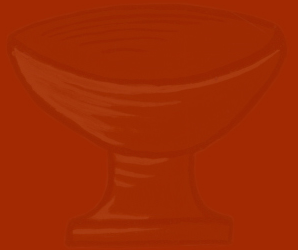
About this icon
Saint Michael is the archangel mentioned in the Book of Revelation 12:7; in the Old Testament. The name Michael signifies "Who is like to God?" and was the war-cry of the good angels in the battle fought in heaven against Satan and his followers. Holy Scripture describes Saint Michael as "one of the chief princes," and leader of the forces of heaven in their triumph over the powers of hell. He is called upon in perils, especially at sea and is considered champion of justice and righteousness.
This icon describes Saint Michael in half figure. His head is gently bowed with the gesture of supplication of the hands, facing towards Christ, as part of the iconostasis.
Saint Michael in supplication
The word deesis means supplication. Icons in supplication describe the attitude of humility and joy towards the figure of Christ. Wherefore God also hath highly exalted him, and given him a name which is above every name: That at the name of Jesus every knee should bow, of things in heaven, and things in earth, and things under the earth; And that every tongue should confess that Jesus Christ is Lord, to the glory of God the Father. Phil 2:9-11
The icon in supplication is intended for the iconostasis. In Eastern Christianity an iconostasis is a wall of icons and religious paintings, separating the nave from the sanctuary in a church. Iconostasis also refers to a portable icon stand that can be placed anywhere within a church.
A number of guidelines or rubrics govern which icons are on which parts of the iconostasis, although there is some room for variation. In its fullest Slavic development it comprised five tiers of icons and usually two or three.
The bottom tier is sometimes called Sovereign. On the right side of the Beautiful Gates (from the nave facing forward) is an icon of Christ, which symbolizes his second coming and on the left side is an icon of the Virgin Mary, symbolizing Christs incarnation, and entrance into this world. Therefore, all things take place between Christ's first and second coming. Other icons on this tier beside those on the doors themselves usually include depictions of the saint or feast to which the church is dedicated, St. John the Baptist, St. Nicholas, one or more of the Four Evangelists etc.
Above this are two interchangeable tiers, the Deisis and the Twelve Great Feasts. In the center of the Deisis is a large icon of Christ Enthroned. To the left and right are icons of John the Baptist and the Virgin Mary in attitudes of supplication. They are often flanked by icons of the Archangels Michael and Gabriel, then Saints. Peter and Paul, and then any other important Church Fathers that may be desired for inclusion as space allows. The Feasts tier contains icons of the twelve major liturgical feasts.
The Sovereign tier is always present, but all the others may be omitted. Preference is given to the Deisis or the Feasts tiers if only some of them can be included. Only the largest and most elaborate iconostases include all five.




